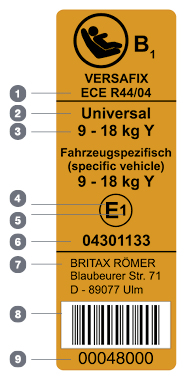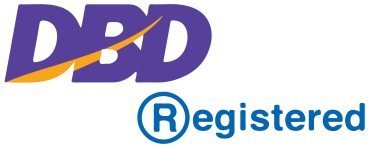Safety Considerations
American child seats are approved according to the US standard FMVSS 213. In Europe, child seats must conform to the European safety standards ECE R44/04 or ECE R129. Therefore we always recommend that parents choose only car seats that conform to the European standards for use in Europe.
across the strong bones of the body.
Why are child car seats with integrated harness often more expensive than car seats with shield systems?
Harnesses are complex to design. The visible part is only a small fraction of the total harnessing system, which comprises straps, tongues, crotch strap, attachment means to the shell and a key element: the buckle. Technology is needed to allow easy tightening and release of the harness, and the harness needs to be routed around the shell to allow connection at the right points for the load to be distributed whilst providing easy access to the parents securing their child in the seat. In addition, designing a shell which can properly withstand the forces the harness places on the upper shell, to effectively restrain the upper body, is technically advanced and costly.
Can I use a second-hand car seat?
We believe that risks shouldn’t be taken when it comes to child safety. A second-hand car seat with an unknown history is always a risk as you cannot be sure that it hasn’t been involved in an accident (even if there are no visual signs of damage).
Can I use car seats from the United States?
What are the legal standards for car seats?
It is mandatory to use child car seats within the EU for all children up to the heights of 1.35m or 1.5m – depending on the member state.
There are currently two legal standards in Europe:
ECE R129
i-Size (this is a new standard for group 0/0+/1 seats that will exist alongside ECE R44/04 for a number of years and sets more advanced safety standards based on more recent safety data).
ECE R44/04
To meet ECE R44/04 approval car seats are tested in frontal collisions at 50km/h and rear collisions at 30 km/h using crash test dummies and advanced measuring instruments designed to assess the levels of protection each seat offers. ECE R44/04 approved seats can all be identified by their orange approval label.
WHAT DOES THE APPROVAL LABEL TELL ME ABOUT MY SEAT?

- Your seat meets the European Safety Standard. Note the last two digits: these should end in 04 (latest version) or 03. R44-01 or 02 are not legal and may not be sold or used since 2008.
- There are 3 types of car seat approval: universal, semi-universal and vehicle specific. ‘Universal’ means your seat is approved for installation in all cars, although you should check that the seat fits really well in your car. See below article on ‘Type Labelling’.
- Approval for weight (group). If a letter Y is added here, it means that the child seat features a 5-point harness system with crotch strap.
- European approval indicator.
- Indicates the country in which the approval was obtained:
1= Germany
2 = France
3 = Italy
4 = The Netherlands etc. - Approval number. The first two numbers (04) show to which version the child seat has been approved, in this case ECE R 44/04.
- Name of product manufacturer
- BAR code
- Unique number allocated to your specific seat, for testing and tracking.
To determine if a child car seat fits your car, there are 3 types of car seat approvals:
Universal approval
The seat is approved for use in all vehicles that meet ECE R14 and R16 regulations. Any Isofix car seat must use the Isofix anchorage points including the top tether or foot support and the vehicle’s handbook must state that the car is suitable for “Universal Isofix child seats”.
Semi-universal approval
Semi-universal approval is when, in addition to the standard requirements, other safety devices for attaching a seat are used and require additional testing. For example: some vehicles provide additional storage space within or beneath the floor area that can influence the behavior of a child seat foot support, therefore you need to check the child seat manufacturer’s car fitting list for your car type and model.
Vehicle specific approval
The child seat is tested in an additional car-specific dynamic crash test and approved only for these cars. The car must be listed in the child seat manufacturer’s car fitting list. This may include special features or designs that can only be installed in a car of a specific type.
i-Size (ECE R129)
i-Size is a new regulation for child car seats that will run in parallel to the current regulation (ECE R44/04) for the next few years. It has been in force since July 9th 2013. We were a major contributor to its development and believe that it will greatly increase protection for little ones across Europe.
The key changes are:
Extended rearward facing travel until a minimum of 15 months
Proven to be the safer way to travel in case of frontal collisions
Added side impact test
To ensure the seat provides better protection in the case of side collisions
ISOFIX only seats
Using our 1997 invention together with Volkswagen to greatly reduce the risk of incorrect installation
Based on the age and size of the child rather than weight
Reflecting the latest safety data and giving parents a clearer indicator of what seat is right for their child and when their child is ready to be moved to the next stage car seat.
i-Size (or ECE R129) approved car seats can be recognized on the orange approval label by the “i-Size” indication. Additionally, one can easily find the appropriate length classification of the car seat on the label. The remainder of the approval label looks alike the ECE R44 label.
What are the benefits of extended rearward facing travel?
Superior protection in a frontal collision
Car seats are designed to absorb crash forces through the shell of the seat and spread the remaining crash forces away from the child’s body. Rearward facing car seats offer the best protection in the event of frontal collisions – the most frequent type of accident on the roads.*
Physics dictates that in the event of a frontal collision, it is safer for a child to travel in a rearward facing car seat as crash forces are directed to the back of the seat, while the remaining energy is spread evenly across the head, neck and upper body. In a frontal collision with a forward facing seat the energy of the impact is distributed differently across the seat structure and restraint system – potentially resulting in more energy impacting on the child’s body.
Our belief in the safety of extended rearward facing is supported by Swedish government advice and by safety organisations across Scandinavia. Sweden has the lowest car crash fatality rates for children in the world.
Experience that counts
We’ve been designing industry-leading car seats for approximately 50 years – and have been championing rearward facing seats in Sweden for over 20 years. During this time we’ve constantly used our learnings to develop innovative ways to make safer, simpler, more flexible products. Our research and development team are continually making advances in energy management – enabling us to enhance the protection that our products offer from every possible angle of impact (including rollovers) in a road traffic accident. We’ve also been able to develop an industry-leading selection of belted seats that enable rearward facing travel beyond the limits of ISOFIX – all the way to 6 years old. Our expertise is regularly shared with governmental bodies and safety experts worldwide.
The Plus Test - driving safety standards higher
The PLUS Test is a voluntary test, which sets demanding standards for a seat’s ability to protect the head and neck in frontal collisions. Currently the PLUS Test is carried out on seats designed for the Swedish market – the only country in Europe where parents transport their children solely rearward facing up to four years. Not all child restraint systems have been able to pass the test since its introduction in 2009. Only nine car seats have passed the PLUS Test successfully – including our MAX-FIX II, HI-WAY II and MAX-WAY.
*Casimir “Child Car Passenger Fatalities - European Figures and In-Depth Study”; Alan Kirk; Loughborough University, UK; Conference: Protection of children in cars, Munich, 2011.
What are the benefits of 5-point harnessing?
Nearly 50 years of experience and constant technical innovation have enabled us to understand in minute detail what happens in different types of collisions. Based on our continually developing knowledge, a 5-point harness system is the only form of restraint we use on all of our Group 0+/1, 1 and Group 1/2 car seats – and we are increasingly finding ways to build extended 5-point harnessing into our Group 2 seats.
What types of restraint systems are available?
In Group 0 and 0+ children are generally restrained with a 3- or 5-point harness.
In Group 1 children are restrained either with the 5-point harness or the shield system (also referred to as safety cushion, impact shield, tray shield).
In Group 2 and 3 children are commonly restrained with an adult seat belt. However we are also working to champion extended 5-point harnessing for Group 2 so that children can benefit from the safety of 5-point harnesses for longer.
How does a 5-point harness work in a collision?
A 5-point harness significantly decreases the forces a child experiences during a crash since the forces are diverted from the child along the harnessing to the five points of contact with the seat. When the child is decelerated by the harness, the cushioning occurs across a wide area and limits shoulder and hip movements, resulting in low stress to the spine and the forces being directed away from the parts of the body containing vital organs.
In case of a roll-over, side impact or an offset impact (where combined vertical, lateral and or oblique loading lateral forces can lead to ejection or submarining), the shoulder contact points and the crotch strap stop those risks and keep the child safely in the protecting seat shell.
In addition, the harness allows for adjustment to the child’s body and therefore offers a good and customised fit.
Why do we use a 5-point harness?
In all 5-point harness seats, the straps come down over the shoulders and across the hips to fasten to the buckle that comes up between the legs. The harness sits closely against the bony parts of the pelvis (the crotch and hip straps) and across the shoulders and rib cage (the shoulder straps). When a child moves forward in the seat, as they would in a crash, the properly tightened harness is already "holding" the child and it effectively restrains them, spreading the crash forces out through the seat and the remaining forces







